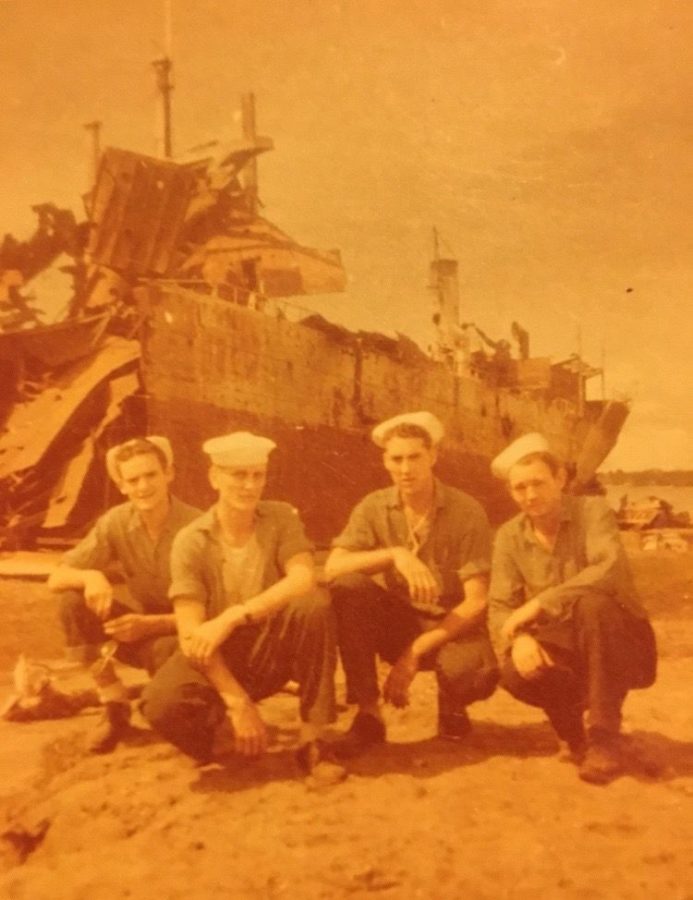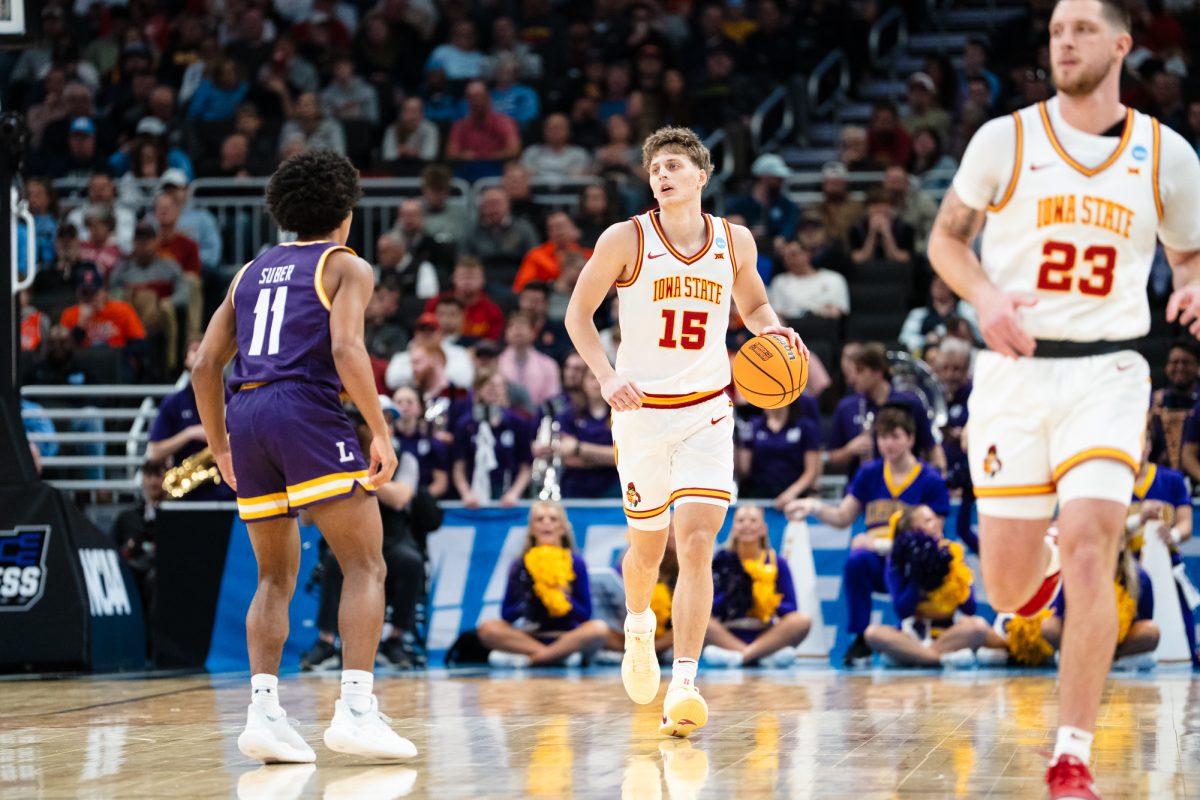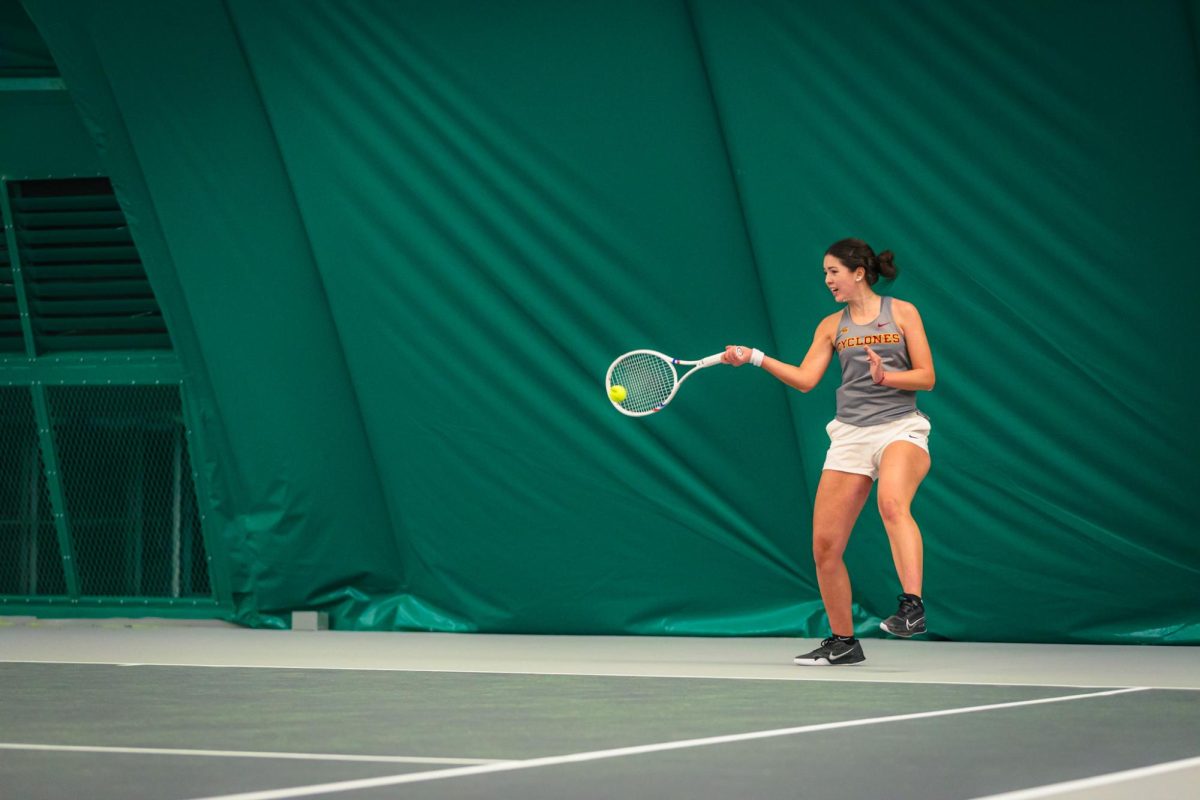My dad’s dream
September 8, 2017
Every football player’s path to getting a Division I playbook in his hands is different.
Most get scholarships. Preferred walk-ons are invited to play.
Others just show up.
That’s what my Dad, Bob Visser, did during the era of Iowa State’s legendary Earle Bruce.
And he gave me the playbook to prove it.
Dealing with death
Neither one of grandparents on my Dad’s side of the family had a high school diploma. My Dad’s family never had a lot of money.
Grandma Edith worked at Sterenberg’s, the local hardware store in Sheldon, Iowa. My Grandpa Ben — yes, I’m named after him — worked on his uncle’s farm and at the Big-4 Co-op Processing Plant.
Before Grandpa Ben started work at the Big-4 Co-op, he served in the U.S. Navy during World War II. He was deployed in the Pacific Theater. While his fleet was on its way to the Philippines, it was hit hard by Japanese kamikaze pilots. Many of the crew members died from the bombings.
My grandfather had a few close calls, but his ship — the DuPage — made it to shore, where they could regroup and make what repairs they could. Grandpa Ben earned six stars during the fight, but more importantly, he learned to leave no man behind.
That’s why, when the Big-4 Co-op sprung a gas leak, a problem turned into a tragedy.
Grandpa Ben saved one of his co-workers who was passed out. He carried him outside, and by then, everyone was accounted for — except one guy.
My Grandpa rushed back in to save him. It was just him and his training to leave no person behind.
He searched and searched, but he was never going to find him. The person was already outside. He had gone out the back door.
My Grandpa died trying to save a life that didn’t need saving.
Ben John Visser died on March 10, 1960, from asphyxiation due to hexane fumes. He was 37.
After my Grandpa’s death, the Big-4 Co-op put procedures in place in case of another gas leak.
But those new procedures didn’t give my Dad his Dad back. He was 10 years old and devastated. He had always followed his dad around like a shadow. Now he was the man of the house, a task he wasn’t sure his 10-year-old shoulders could bare.
But he could only mourn for so long; he had to persevere.
The community wanted to rally around my Dad’s family.. The church came forward and wanted to help with some of the bills.
My Grandma was too proud, too stubborn and too driven to take any handouts.
She and her children would work. They didn’t need any help.
My Dad started working when he was 15 at Swanson’s, the local grocery store. His sister Lorene started working the same year at Broadles Dress Shop. She was 16.
When my Dad’s chance to play high school football came, he couldn’t. He was busy bagging groceries while his friends were playing under the Friday night lights.
Draft day
After graduating from high school, my Dad elected to forgo college and work construction. He did that for a year — a year in which he saw all his friends go off to college.
First football, now college.
He decided he wasn’t about to let his friends do something that he wasn’t able to do — again, for a second time.
He enrolled at Northwestern College in Orange City, Iowa.
The year was 1970. It was the year that President Richard Nixon appeared on TV with a fishbowl full of dates. He’d start at No. 1 and work his way through No. 365. The first date he’d pull out would be No. 1, the second date No. 2 and so forth.
Essentially, anyone under No. 200 was getting drafted and heading for Vietnam.
My Dad and his friends gathered around the TV. They were cracking jokes, attempting to make a very serious situation a little lighter. They knew most of them would probably get drafted.
Nixon pulled the first date out of the bowl.
They were all safe.
Nixon reached in for the second date, stared into the camera and read, “April 24, 1950.”
The room fell silent.
The jokes stopped.
Everyone looked at my Dad.
His draft number was No. 2.
His plans to finish college were put on hold.
On Jan. 19, 1971, he joined the Army.
Basic training was at Ft. Leonardwood, Mo. Anyone who was fit and could keep up with the group was infantry. My Dad was fit. He moved on to advanced training at Ft. Polk, La., which mimicked the environment and terrain in Vietnam.
“All your drill sergeants in basic training are trying to shape you up,” my Dad said. “But the drill sergeants in advanced training are trying to keep you alive. They don’t want to see you come home in a body bag.”
Because U.S. soldiers were dying, the nation was protesting, and Nixon was being pressured to get out of Vietnam. For once my Dad’s timing was good. He never was deployed to Vietnam.
Instead, he went to Ft. Riley, Kan.
“I thought, ‘Thank you Lord,’” my Dad said. “Now maybe I can relax and sort this out.”
He asked to sign up with the Army Corp of Engineers to learn drafting. Architecture and design had always interested him. This was his opportunity to see if he liked it.
He did.
And when he was discharged on Jan. 19, 1973, he was accepted to Iowa State, where he studied architecture.
“You’re nuts”
Iowa State was on the quarter system when my Dad enrolled in Fall 1973.
Not only did he attend all his classes, but he also attended every football game.
He started thinking. He missed football in high school. He wasn’t going to miss football in college.
My 5-foot-9, 170-pound Dad thought he was going to walk on to a Division I football team.
It made sense — sort of.
He was always a good athlete, even though he never played organized sports. He had just gotten out of the Army, so he was in peak physical shape. A better time couldn’t present itself.
He told his roommate about his plan, to which his roommate responded, “You’re nuts.”
My Dad was not discouraged. He walked over to the football offices located at the west end of the old Clyde-Williams Stadium. He talked with the secretary about the process of walking onto the football team.
She told my Dad that he was in luck because head football coach Earle Bruce, who had just finished his first season coaching the Cyclones, was in his office. He followed her to Bruce’s office, and my Dad told the coach his story and expressed his desire to become a walk-on.
Bruce welcomed him with open arms.
“If you’re fit to serve our nation, you’re fit to play for us,” said Bruce, who went 36-32 in his six seasons coaching Iowa State before leaving to become a legend at Ohio State. “Come by tomorrow and we’ll get you suited up.”
The next day my Dad ran over to Clyde-Williams after his classes got done at 2:30.
The equipment manager hooked him up with all the latest swag, which was a white t-shirt, white shorts and white Keds tennis shoes. The season was over so that’s all the players got for winter workouts.
My Dad put the gear on, walked over to the weight room with the rest of the team and got to work with the defensive backs.
As my Dad got to know his teammates and position coaches during the winter workouts, he realized how lucky he was. For the first time, he felt what it was like to be a part of a football team — a feeling he had been looking for since high school, only now, it was at the Division I level with some of the best athletes in the United States lifting weights and running sprints right beside him.
“I couldn’t believe some of the guys who were bench pressing 300-400 pounds,” my Dad said. “I thought, ‘That ain’t me.’”
My Dad got through the winter workouts and made it to the spring practices.
He got his playbook.
He also got his jersey. Number 2.
Same as his draft number.
At that time, Iowa State had a freshman team and varsity team. Any newcomer was automatically placed on the freshman team until he proved that he had the ability to play on the varsity team.
The way the coaches would tell players about their promotion to the varsity team is by moving their nameplate from the freshman locker room to the varsity locker room.
In the spring of 1974, my Dad walked into the freshmen locker room, sauntered over to his locker, and his name was no longer there. He wasn’t sure if he had been kicked off the team. He was shocked and momentarily confused.
Then reality set in. His nameplate was among the first to be moved to the varsity locker room.
When the first two-deep depth chart came out in the spring, his name on it, listed as the No. 2 weak-side cornerback behind returning starter Tony Hawkins.
He couldn’t believe it.
Not only did my Dad walk onto a Division I football team and get a Division I playbook, but he had a good chance of seeing the field. He was an injury or a broken chinstrap away.
But he knew had to take it one step at a time. The spring game came first.
During the game, Hawkins left the field, and my Dad put on his helmet, rushed on the field and into the defensive huddle.
He was about to play football in Clyde-Williams Stadium in front of fans.
He couldn’t believe it.
His stomach was in his throat.
He couldn’t feel his limbs.
In the huddle, they got the play. When they lined up, he recognized the offensive formation. His hours of studying the playbook had paid off. They were about to throw a swing pass to his side.
The coaches knew Bob Visser was the new guy, the inexperienced guy. Why not try to take advantage?
My Dad read the play, reacted and dropped the running back for a loss of one yard.
Hawkins returned for the next play. That was the only snap my Dad played that day.
Afterward, my Dad and his friends gathered around the TV in their Richardson Court dorm rooms watching a replay of the spring game from the local television station.
My Dad’s play was coming up. All his friends shouted, “There’s you. There’s you! Quiet. Quiet!”
They watched him blow up the play in the backfield. Then they heard the TV sportscaster say, “Dave Visser with the tackle in the backfield.”
Not quite my Dad’s name. He didn’t care.
My Dad went home for the summer feeling good about his standing on the team. There were no organized team workouts over the summer. NCAA rules prohibited them, so a lot of players did their workouts at home. My Dad worked construction to help offset the cost of living; he was going to school on the GI bill, so everything but the cost of living was accounted for.
He worked construction during the day. In the evening, he worked out using Bruce’s regimen.
The work ethic my Grandma instilled in my Dad propelled him through the summer, and he returned to Iowa State in peak condition. Near the end of a fall practice, Bruce singled out my Dad and yelled to the team, “If y’all would’ve taken your workouts as seriously as Visser, we wouldn’t still be running!”
Everything was going well on the practice field — until my Dad registered for fall classes.
One of his professors only offered his class in the afternoon. My Dad, an architecture major, needed the class. It overlapped practice by an hour. My Dad tried to reason with the professor, but the professor wasn’t having any of it. My Dad told his position coach, Charlie Lyle, about the problem. Lyle told my Dad to tell Bruce, and he would take care of it.
Only my Dad wouldn’t do that. My Dad needed to focus on school. His future was as an architect, not as a football player. The most he could ever achieve on the field would be a couple of snaps here and there and a special teams spot.
He didn’t want to get on that professor’s bad side and have it impact his grades.
He never told Bruce about the class conflict; he just turned his gear in and explained to Bruce his decision. The coach understood and wished him the best of luck.
When that class was over each day, my Dad went back over to the field to watch his friends and former teammates practice. On Saturdays, he was in the stands cheering them on.
The ugly twist of fate? The professor that wouldn’t let him go out for football was a practicing architect from Des Moines who taught the class on the side. The next quarter that professor was gone, and he never taught another class at Iowa State.
But my Dad was done with football. He got to experience what it was like to be on a team for eight months.
And he got his playbook.
Family legacy
My Dad let my sister, Whitney, and I play any sport we wanted to growing up, and he’d even pay for lessons and camps to ensure we would be the best we could be. I never realized how lucky we were or really why he did that until recently.
He did it for us, because he wasn’t able to.
And not only did he allow us and pay for us to do all of these sports, he also coached us.
My sister fell in love with tennis. That was her sport. She played for Central College, a Division III school in Pella, Iowa. But before she accomplished that, my Dad would take her to the tennis courts at the local park just down the street from our house. He hit with her for hours day in and day out so she could perfect her ground strokes.
He coached my baseball teams from second grade through middle school.
And we were successful. We won the Sioux Falls city tournament in 2004. We were always one of the top teams in the city. And eventually, when we got to legion baseball, the state.
I played baseball, basketball, football — which he also helped coach — golf, tennis, soccer.
Any sport. Any time.
Now I understand why. Because he wanted to give us the opportunities that he never had.
It wasn’t just playing sports, though; it was going to football games.
Iowa State football games.
He would take my mom, my sister and me to every game he could. It was more than a four-hour drive from Sioux Falls, but for my Dad, it might as well have been a four-minute drive. He didn’t care, he just wanted us to experience what he got to experience.
If it was an 11 a.m. kickoff, we’d hop in the 2002 silver Jeep Liberty at 4:30 in the morning to start our trek. I’d sleep the whole way down, but once we got there, he made sure to take us to every stop on campus. The Campanile, the Memorial Union and, of course, the design building.
After the campus tour — which happened more often than it should have, but I won’t fault his passion — we would go to the bookstore. He would buy me a mini Iowa State football. I have about 10 more than I need. Then we would head to the tailgating lots. Being from Sioux Falls, we never had a spot of our own, but I loved the atmosphere and the smell of the grills.
Eventually we’d make it into the game and enjoy every second.
I cheered on Sage Rosenfels in my No. 18 jersey; I cheered on Lane Danielson in my No. 82 jersey; I cheered on Todd Blythe in my No. 1 jersey.
I have autographs from Seneca Wallace, Ennis Haywood and Dan McCarney.
We were there for the Nebraska upset in 2004, where everyone, including us, rushed the field a la Oklahoma State in 2011. We were also there for the tornado game against Colorado in 2005.
I have too many vivid memories to get to, but rest assured, it was my Dad who made them memorable.
When it came time for me to choose a college, there was only one choice: Iowa State.
Of course, I bought the all-sports pass as a freshman, and I remember going to the first game of the season in 2012 against Tulsa.
I was walking to the stadium with a few people I had just met from the dorms. We were talking, laughing and joking. We were making game and season predictions — the normal pregame banter.
Something was off, though, and while we were making our way through the tailgate lots, I remember tweeting,
It’s weird walkin to isu football games without my dad
— Ben Visser (@BenVisser43) September 1, 2012
Iowa State beat Tulsa that day 38-23, but it still didn’t feel right.
From that game on, I wore my Dad’s No. 2 Iowa State jersey with “VISSER” across the back.
After nearly 40 years, the jersey finally made its long-awaited return to an Iowa State stadium. And it didn’t miss a game.







